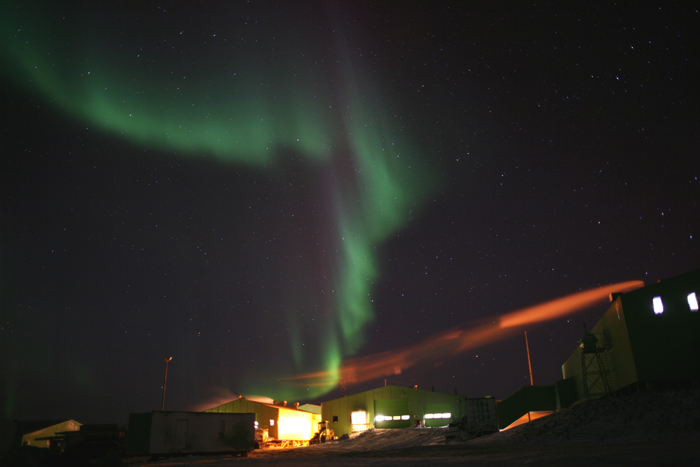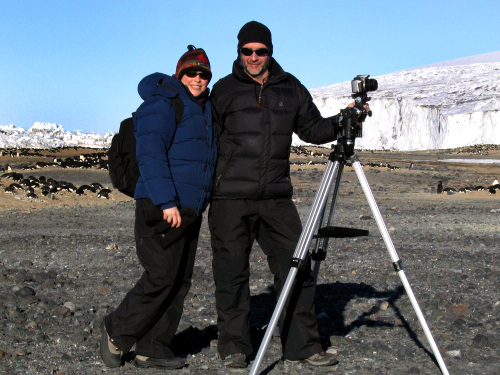
Photo Credit: Anthony Powell |
An aurora shimmers above New Zealand's Scott Base during the austral winter in Antarctica. This is one of more than a million pictures that photographer Anthony Powell has shot for a time lapse film he is creating about what life is like during the course of a year in Antarctica. |
A year in the life
Powell's time lapse film offers unique look at Antarctica
By Peter Rejcek, Antarctic Sun Editor
Posted April 11, 2008
The short film opens with the moon streaking behind the dome-shaped top of Mount Discovery, as twilight briefly splashes red on the face of the volcanic cone. In the subsequent scene, the moon appears again, dramatically flying past a wooden cross on Observation Hill overlooking McMurdo Station.
Next, come the auroras: shimmering green sheets of light, soft and ephemeral, then almost solid and powerful, curtains billowing in a cosmic wind. Violin music plays softly, achingly, and then suddenly an entire orchestra rushes in as the southern lights blaze across the night sky in a quick succession of scenes.
The clip, not even two minutes long, perhaps says more about the mystery and awe that Antarctica inspires than just about any feature length film. Just think what photographer Anthony Powell can do with 70 minutes of time-lapse footage as he tells the story of a year living on the Ice.
“A lot of [my work is] just trying to convey the feeling of the place. Regular photos and videos quite often just don’t do it justice,” Powell says in a soft New Zealand accent. “When I saw what was possible with the time lapse, I felt like it captured the essence of it a lot better. A lot of people have commented to me that it’s the only thing they’ve seen that conveys the feeling of [Antarctica] as they see it.”
Powell’s normal day job — well, night job — is as a satellite communications engineer at McMurdo Station. He’s on his sixth straight austral winter, monitoring and maintaining the satellite equipment that keeps McMurdo connected to the rest of the world. But he recently completed a short summer stint on the Ice — as a photographer under the National Science Foundation’s Antarctic Artists and Writers Program.
The program sponsors six or more artists, writers, photographers, painters and other über-creative types each year to produce work about the Antarctic. The grant doesn’t come with any money, but provides access to many of the same areas visited by scientists in the U.S. Antarctic Program.
Powell says the program gave him the freedom to go where he needed for his film project, which he took up in 2003. Previously, he only worked on the time-lapse photography during free time from his six-day-a-week job. And, just as important, it allowed him to work on his own time schedule, often late into the night to capture the soft light of the midnight sun.
“It’s the main thrust for why I wanted to come down during that time of the year, so I could round out the full year of footage, so I can present what it’s like for a full year on the Ice,” he says. “The few weeks I was down here for the summer I gathered as much footage as I had in the previous two winters.”
Powell creates the time-lapse films by taking individual still photos on a digital SLR camera, then converting each individual photo into one frame of film or video. At 24 frames per second, it soon adds up, he says, estimating he’s shot more than “one million individual photos, filled up several hard drives, worn out a number of cameras, and broken quite a bit of other camera equipment in the process.”
He uses an external timer to take a photo every second, or perhaps once every couple of minutes, depending on the type of effect he wants to create. A modified tripod also provides motion, if Powell, say, wants to create a 360-degree view of the sun as it circles the horizon.
.jpg)
Photo Credit: Christine Powell
Anthony Powell prepares a camera for a shot around McMurdo Station.

Photo Courtesy: Christine Powell
Christine and Anthony Powell in the field at Cape Bird.
The effect can seem frenzied, when watching something like tractors preparing an airfield landing strip or snow road, zipping across the screen, spitting out a constant stream of snow like a lawnmower cutting grass at high speed. Or surreal, as the snow trapping a heavy chain quickly melts in Powell’s digitized time warp; the chain appears to collapse like a slinky dropping down a stairway.
Powell’s wife, Christine, assisted him with the summer project, including shooting video and maintaining a blog of their day-to-day work. An American who has worked in the U.S. Antarctic Program since 1997, Christine Powell says photography is her husband’s passion.
“Speeding it up from a photograph and slowing it down from a video, somewhere in the middle, somehow it captures a bit of magic,” says Christine Powell, who has wintered at McMurdo Station seven times, including five in a row. “I’m not sure what that [magic] is, but it allows you to see patterns of things that you wouldn’t normally see, because we only see things in real time.
“There’s a lot of stuff going on down [in Antarctica], but it’s happening slowly,” she adds. “The time lapse really helps you see what’s going on — the changing of the clouds, the patterns, and the light and the dark.”
Music is a key element in the time-lapse films, seeming to set the tempo of the motion that Powell captures. For the feature film he envisions, Powell has enlisted the help of Wellington, N.Z.-based Plan 9 Music, a group of composers and long-time musicians who have worked on a number of TV and film projects. Plan 9 is best known for its work on director Peter Jackson’s Lord of the Rings movies.
“They’re really excited about the project,” Anthony Powell says. This will be the first time he will have music specifically written for his footage, which has him excited as well. “Now, instead of making the clips fit the music, it’ll be more the music will be made to fit the clips, so it will free me up more in what I can do in that respect,” he says.
David Donaldson, one of the composers for Plan 9, explains he came across some of Powell’s clips on the video-sharing Web site YouTube™, and was immediately fascinated by what he saw.
“One of the appeals of Anthony’s stuff is that a lot of it’s going to be visual images and music. That’s a lot of scope with what you can do with that,” Donaldson says by phone from his Wellington studio. “The footage is absolutely incredible. As soon as we saw it we said, ‘We’re in. We’re definitely in.’ That footage that he’s got, there are not many people who could even come close to making that.”
Those five weeks in the summer took the Powells to the South Pole, Lake Vanda in the McMurdo Dry Valleys, and penguin colonies around Ross Island. Powell often had four sets of cameras working simultaneously, usually to capture very different scenes, which could last up to 48 hours or longer.
For the footage at South Pole, Powell modified an ice cooler to help keep the cameras warm, as even summer time temperatures are 50 degrees or more below freezing. He cut a hole in a cooler and attached a security camera dome to the outside. He then put a heating element and camera mount inside the box, powering the whole thing with a car battery.
“Cameras seem to work okay down to around about minus 20 as long as you’ve got a good power supply, but once you get much below that the mechanisms start to freeze up, so you need to provide some insulation and heating,” Powell explains.
The goal this winter is to process and edit the summer footage in his spare time, as well as re-render all of the original raw photos from the last five years into high-definition. Of course, Powell will find time to add to his vast database of photos.
“I can already think of some shots that I don’t have that I need to get,” he says. “When you spend a little bit of time in a place and just sort of observe the environment for a while, you’ll start to recognize the changes and find other things to concentrate on.”
NSF-funded project: Anthony Powell, Antarctic Artists and Writers Program.





.jpg)

